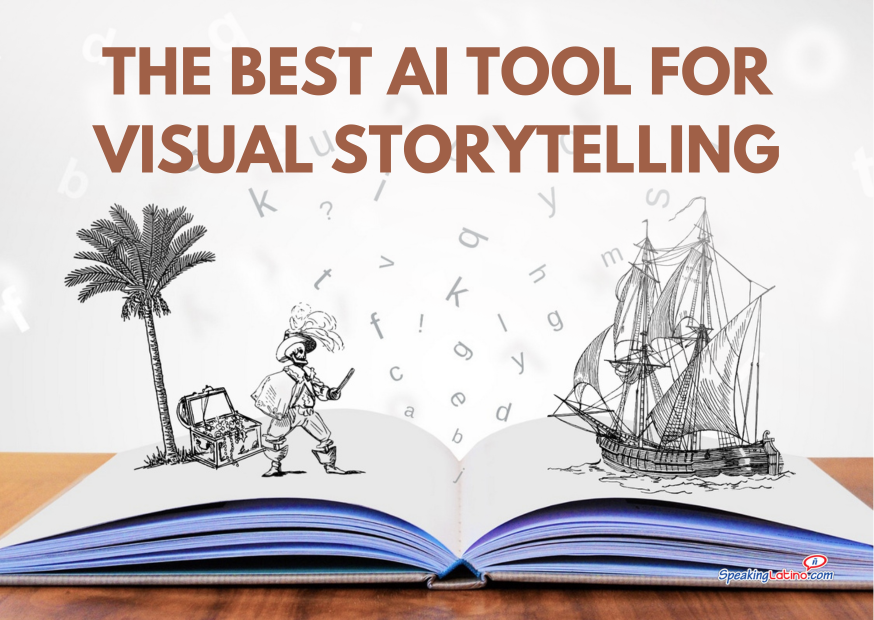
The content of this article is based on the presentation, Genial.ly and AI Creating Visual Stories by Jennifer Niño, which was part of the World Language Teacher Summit.
The Digital Revolution in Classroom Storytelling
The advent of digital resources and artificial intelligence (AI) has not only transformed the educational landscape but also has revolutionized the way educators teach and students learn languages. No longer are the days of static, text-heavy lessons; instead, we are embracing an era where interactivity and visual storytelling are at the forefront of language acquisition.
Through the power of tools like Genial.ly and Canva, language educators are now equipped to craft engaging and dynamic narratives that captivate the curiosity of learners and make the educational journey both fun and effective.
The Role of AI in Crafting Interactive Lessons
AI is more than a technological marvel; it's a springboard for creativity. In the context of language education, AI tools like sentence generators and image creators serve as an invaluable asset to educators. They assist in crafting prompts that are both engaging and tailored to the specific learning objectives of a class.
By harnessing AI, educators can produce captivating stories that resonate with students and foster an interactive learning environment.
Enhancing Language Learning through Genially
Genial.ly, an online tool designed to create interactive visual content, stands as a testament to the power of storytelling in the classroom.
Teachers can use this tool to weave a narrative that brings grammar lessons to life. Images and sentences generated through AI converge in a Genial.ly presentation, challenging students to connect what they see with what they hear in a cohesive and compelling storytelling exercise.
Designing Engaging Classroom Activities: Structuring Interactive Narratives
Effectiveness in using AI tools for educational purposes lies not only in the visuals and text generated but also in how these elements are presented to the students. Educators can manipulate when and how text and images are displayed within a Genial.ly presentation, thus ensuring a controlled pace conducive to learning.
By incorporating listening comprehension and storytelling into the design, interactive stories become more than a lesson; they transform into an experience that fuels both curiosity and language proficiency.
Incorporating Authentic Dialogues
Creating a believable and engaging dialogue for students involves integrating elements that resonate with their everyday lives, such as the informal tone and chat language features of modern communication.
Using templates, educators can tailor dialogues to suit different levels of language proficiency and include intentional grammar or spelling mistakes to reflect authentic language use. These dialogues can then be adapted into interactive exercises with varying degrees of difficulty, providing a realistic language practice that meets the needs of diverse learners.
Utilizing Interactive Questions and Exercises
To reinforce concepts and vocabulary introduced in the dialogue, interactive questions of various types—ranging from multiple choice to sorting activities—are an essential component of the learning process.
These interactive elements are methodically designed with specific settings and animations to foster engagement and assess comprehension effectively. Asking AI, such as chat GPT, to generate reading and comprehension questions about the dialogue ensures that the questions are relevant and challenging, adding further depth to the learning journey.
Creating Contextually Relevant Projects
AI is not limited to storytelling; it can be applied to an array of contextually relevant projects. For instance, educators might engage students in an activity that involves the creation of traffic signs equipped with bespoke icons and prompts.
Such an exercise not only stimulates creativity but also enables students to connect vocabulary with visual elements, thereby bridging the gap between conceptual learning and practical application.
Facilitating Home Vocabulary Acquisition
The application of Genial.ly extends beyond stories and signs into the realm of dialogue-based learning activities.
For example, the construction of a house can serve as a basis for teaching relevant vocabulary. An interactive dialogue between the teacher and student, crafted in Genial.ly, guides the learner through various vocabulary exercises based on their responses. Such approaches make the lesson an active conversation and provide immediate, contextual learning opportunities that align with the student's interests and choices.

By incorporating listening comprehension and storytelling into the design, interactive stories become more than a lesson
Sourcing Visuals
When it comes to obtaining visual resources such as icons for educational projects, platforms like Freepik and Canva are invaluable. They offer a plethora of free resources which educators can then customize to suit the thematic needs of their lessons. By exploring how to navigate these platforms effectively, educators are empowered to create professional-grade visual content that is both engaging and didactic.
Creating an Interactive Learning App
One of the crowning achievements of incorporating AI and digital storytelling into education is the ability to create what is essentially an interactive learning app within a lesson. By embedding exercises into a Genial.ly presentation and utilizing iframe codes for seamless integration, educators transform an ordinary lesson into a multifaceted educational tool. This in-lesson app becomes a one-stop-shop for language practice, reinforcing the acquisition of new vocabulary and concepts through a variety of interactive exercises.
FAQs About AI and Visual Storytelling
How can AI tools be used to enhance language education for students?
AI tools can be utilized in various ways to enhance language education for students:
- Personalized Learning: AI can analyze individual student performance and provide personalized recommendations for improvement.
- Language Practice: AI-powered language learning platforms can offer interactive exercises, quizzes, and simulations to help students practice and improve their language skills.
- Language Assessment: AI can assist in assessing students' language proficiency through automated grading of assignments, tests, and spoken language exercises.
- Language Generation: AI can help students generate language content, such as writing prompts, story ideas, and dialogues, to enhance their creativity and language production skills.
- Language Translation: AI translation tools can aid students in understanding foreign language texts, improving their comprehension and vocabulary acquisition.
- Pronunciation Practice: AI speech recognition technology can provide feedback on students' pronunciation, helping them refine their speaking skills.
- Language Immersion: AI-powered virtual reality and augmented reality applications can create immersive language learning experiences, allowing students to practice in realistic language environments.
- Language Feedback: AI chatbots and language tutors can offer instant feedback and support to students, promoting continuous learning and improvement.
- Language Analysis: AI can analyze large amounts of language data to identify patterns, trends, and areas for improvement in language teaching and learning.
- Language Engagement: AI tools can enhance student engagement through gamification, interactive storytelling, and multimedia content, making language learning more enjoyable and effective.
What are some examples of visual storytelling techniques that can be implemented in the classroom?
Visual storytelling techniques can be effectively implemented in the classroom to enhance language learning and engagement. Here are some examples:
- Storyboards: Students can create visual storyboards to illustrate key events, characters, and settings in a narrative, helping them understand and retell stories in the target language.
- Comic Strips: Using comic strips, students can create dialogues, narratives, and sequences of events in a visually engaging format, promoting creativity and language practice.
- Infographics: Students can design infographics to visually represent information, vocabulary, and concepts in a clear and concise manner, aiding comprehension and retention.
- Digital Presentations: Students can use tools like Genially to create interactive and multimedia-rich presentations that incorporate visuals, text, audio, and video to tell stories and convey information.
- Visual Timelines: Students can construct visual timelines to sequence events, historical periods, or story plots, enhancing their understanding of chronological order and narrative structure.
- Picture Books: Students can create their own picture books with illustrations and text to narrate stories, describe scenes, and practice storytelling in the target language.
- Virtual Tours: Using virtual reality or augmented reality applications, students can take virtual tours of cultural landmarks, cities, or historical sites, immersing themselves in language-rich environments.
- Interactive Maps: Students can create interactive maps with multimedia elements to explore geographical locations, cultural practices, and language variations, fostering a deeper understanding of language and culture.
- Visual Vocabulary Cards: Students can design visual vocabulary cards with images, definitions, and examples to reinforce vocabulary acquisition and retention in a more engaging way.
- Digital Storytelling Platforms: Students can use digital storytelling platforms like Storybird or Adobe Spark to create multimedia stories combining text, images, and audio, showcasing their language skills and creativity.

Interactive questions are an essential component of the learning process
How can Genial.ly and Canva be utilized to bring AI narratives to life in language teaching?
Genially and Canva are powerful tools that can be leveraged to enhance AI narratives and storytelling in language teaching:
- Interactive Presentations: Genial.ly allows educators to create interactive and engaging presentations with multimedia elements, animations, and interactive features that can bring AI-generated narratives to life in language lessons.
- Visual Storytelling: Canva provides a user-friendly platform for designing visually appealing graphics, illustrations, and layouts that can complement AI narratives and enhance the storytelling experience for language learners.
- Multimedia Integration: Both Genial.ly and Canva support the integration of multimedia content such as images, videos, audio clips, and animations, enabling educators to enhance AI narratives with rich visual and auditory elements in language teaching.
- Gamification Elements: Educators can use Genial.ly and Canva to incorporate gamification elements such as quizzes, interactive exercises, and challenges into AI narratives, making language learning more interactive and engaging for students.
- Adaptive Learning Paths: Genially's interactive features allow educators to create adaptive learning paths based on students' responses and progress, tailoring AI narratives to individual learning needs and providing personalized language learning experiences.
- Collaborative Storytelling: Canva's collaborative features enable students to work together on creating visual elements for AI narratives, fostering teamwork, creativity, and language practice in a collaborative storytelling environment.
- Visual Templates: Both Genially and Canva offer a wide range of customizable templates for presentations, infographics, posters, and other visual materials that educators can use to quickly design and showcase AI narratives in language teaching.
- Accessibility and Inclusivity: Educators can use Genially and Canva to create accessible and inclusive AI narratives by incorporating features such as text-to-speech, subtitles, alt text for images, and other accessibility tools to cater to diverse learning needs in language education.
- Data Visualization: Both platforms enable educators to visualize language data, student progress, and learning outcomes through charts, graphs, and infographics, allowing for a more comprehensive analysis and evaluation of the effectiveness of AI narratives in language teaching.
- Creative Expression: Genially and Canva empower students to express their creativity, language skills, and storytelling abilities through the creation of visually engaging projects, presentations, and narratives that showcase their language proficiency and artistic talents in a digital format.
The Future of Language Learning with AI
The incorporation of AI and visual storytelling tools into language education has not only revolutionized teaching methodologies but has also paved a new way for students to learn. By leveraging the capabilities of AI, educators are capable of crafting novel educational experiences that are both engaging and effective. From creating compelling narratives enhanced with interactive elements to developing dialogue-based applications for vocabulary acquisition, AI has facilitated a learning environment that is both innovative and tailored to meet the diverse needs of students.
The future of language education is one where AI plays a pivotal role in shaping how students interact with and absorb new languages, setting the stage for a more dynamic and immersive learning experience.